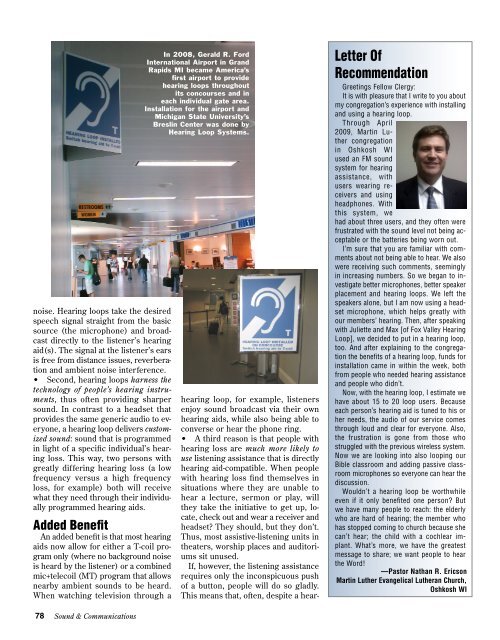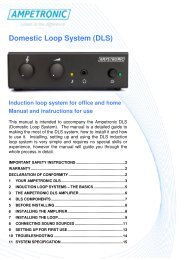Sound and Communications - Hearing Loop
Sound and Communications - Hearing Loop
Sound and Communications - Hearing Loop
Create successful ePaper yourself
Turn your PDF publications into a flip-book with our unique Google optimized e-Paper software.
noise. <strong>Hearing</strong> loops take the desired<br />
speech signal straight from the basic<br />
source (the microphone) <strong>and</strong> broadcast<br />
directly to the listener’s hearing<br />
aid(s). The signal at the listener’s ears<br />
is free from distance issues, reverberation<br />
<strong>and</strong> ambient noise interference.<br />
• Second, hearing loops harness the<br />
technology of people’s hearing instruments,<br />
thus often providing sharper<br />
sound. In contrast to a headset that<br />
provides the same generic audio to everyone,<br />
a hearing loop delivers customized<br />
sound: sound that is programmed<br />
in light of a specific individual’s hearing<br />
loss. This way, two persons with<br />
greatly differing hearing loss (a low<br />
frequency versus a high frequency<br />
loss, for example) both will receive<br />
what they need through their individually<br />
programmed hearing aids.<br />
Added Benefit<br />
An added benefit is that most hearing<br />
aids now allow for either a T-coil program<br />
only (where no background noise<br />
is heard by the listener) or a combined<br />
mic+telecoil (MT) program that allows<br />
nearby ambient sounds to be heard.<br />
When watching television through a<br />
In 2008, Gerald R. Ford<br />
International Airport in Gr<strong>and</strong><br />
Rapids MI became America’s<br />
first airport to provide<br />
hearing loops throughout<br />
its concourses <strong>and</strong> in<br />
each individual gate area.<br />
Installation for the airport <strong>and</strong><br />
Michigan State University’s<br />
Breslin Center was done by<br />
<strong>Hearing</strong> <strong>Loop</strong> Systems.<br />
hearing loop, for example, listeners<br />
enjoy sound broadcast via their own<br />
hearing aids, while also being able to<br />
converse or hear the phone ring.<br />
• A third reason is that people with<br />
hearing loss are much more likely to<br />
use listening assistance that is directly<br />
hearing aid-compatible. When people<br />
with hearing loss find themselves in<br />
situations where they are unable to<br />
hear a lecture, sermon or play, will<br />
they take the initiative to get up, locate,<br />
check out <strong>and</strong> wear a receiver <strong>and</strong><br />
headset They should, but they don’t.<br />
Thus, most assistive-listening units in<br />
theaters, worship places <strong>and</strong> auditoriums<br />
sit unused.<br />
If, however, the listening assistance<br />
requires only the inconspicuous push<br />
of a button, people will do so gladly.<br />
This means that, often, despite a hear-<br />
Letter Of<br />
Recommendation<br />
Greetings Fellow Clergy:<br />
It is with pleasure that I write to you about<br />
my congregation’s experience with installing<br />
<strong>and</strong> using a hearing loop.<br />
Through April<br />
2009, Martin Luther<br />
congregation<br />
in Oshkosh WI<br />
used an FM sound<br />
system for hearing<br />
assistance, with<br />
users wearing receivers<br />
<strong>and</strong> using<br />
headphones. With<br />
this system, we<br />
had about three users, <strong>and</strong> they often were<br />
frustrated with the sound level not being acceptable<br />
or the batteries being worn out.<br />
I’m sure that you are familiar with comments<br />
about not being able to hear. We also<br />
were receiving such comments, seemingly<br />
in increasing numbers. So we began to investigate<br />
better microphones, better speaker<br />
placement <strong>and</strong> hearing loops. We left the<br />
speakers alone, but I am now using a headset<br />
microphone, which helps greatly with<br />
our members’ hearing. Then, after speaking<br />
with Juliette <strong>and</strong> Max [of Fox Valley <strong>Hearing</strong><br />
<strong>Loop</strong>], we decided to put in a hearing loop,<br />
too. And after explaining to the congregation<br />
the benefits of a hearing loop, funds for<br />
installation came in within the week, both<br />
from people who needed hearing assistance<br />
<strong>and</strong> people who didn’t.<br />
Now, with the hearing loop, I estimate we<br />
have about 15 to 20 loop users. Because<br />
each person’s hearing aid is tuned to his or<br />
her needs, the audio of our service comes<br />
through loud <strong>and</strong> clear for everyone. Also,<br />
the frustration is gone from those who<br />
struggled with the previous wireless system.<br />
Now we are looking into also looping our<br />
Bible classroom <strong>and</strong> adding passive classroom<br />
microphones so everyone can hear the<br />
discussion.<br />
Wouldn’t a hearing loop be worthwhile<br />
even if it only benefited one person But<br />
we have many people to reach: the elderly<br />
who are hard of hearing; the member who<br />
has stopped coming to church because she<br />
can’t hear; the child with a cochlear implant.<br />
What’s more, we have the greatest<br />
message to share; we want people to hear<br />
the Word!<br />
—Pastor Nathan R. Ericson<br />
Martin Luther Evangelical Lutheran Church,<br />
Oshkosh WI<br />
78<br />
<strong>Sound</strong> & <strong>Communications</strong>



